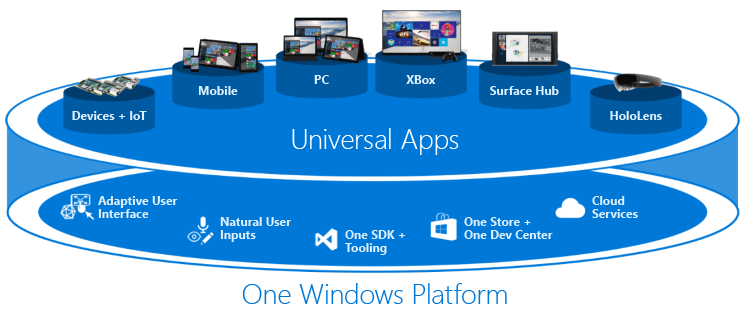Links of Interest:
MSJC MCSD Programs:
Best Jobs
Top Tech Jobs

U.S. News and World Report ranked
Software Developers as their #1 technology job for 2023 citing a median salary of $120,730 per year. Their rankings are based in part on a U.S. Labor Department report touting Software Developers as one of the fastest growing jobs of the decade citing the projected number of jobs to be 370,000. Information Security Analysts have a projected median salary of $102,000 and 56,500 jobs. Web developers median salary is projected to be $77,030 with 28,900 projected jobs. One other perk, a large portion of these jobs will be located in the Golden State.
Introduction
 Figure 1: The new Microsoft .NET Core framework gives C# developers the ability to target multiple devices on multiple platforms.
Figure 1: The new Microsoft .NET Core framework gives C# developers the ability to target multiple devices on multiple platforms.
The CIS C# Programming track provides scholars with an opportunity to learn skills and technologies which are literally on the bleeding edge of modern day application development.
CIS Course to MCSD Exam Matrix
| MTA Exams |
105A |
115A |
125A |
116B |
113C |
123C |
| 98-361: Software Development Fundamentals |
X | | | | X |
|
| 98-375: HTML5 App Development Fundamentals |
X |
X |
X |
X |
|
|
| MCSD Exams
(Web Applications) |
|
|
|
|
|
|
| 70-480: Programming in HTML with JavaScript and CSS |
X |
X |
X |
X |
|
|
| 70-486: Developing ASP.NET MVC 4 Web App |
X |
X |
X |
X |
|
|
| 70-487: Developing Windows Azure and Web Services |
|
|
|
|
|
|
| MCSD Exams (Windows Store Apps using HTML5) |
|
|
|
|
|
|
| 70-480: Programming in HTML5 with JavaScript and CSS3 |
X |
X |
X |
X |
|
|
| 70-481: Essentials of Developing Windows Store Apps Using HTML5 and JavaScript |
X |
X |
X |
X |
|
|
| 70-482: Advanced Windows Store App Development Using HTML5 and JavaScript |
X |
X |
X |
X |
|
|
| MCSD Exams (Windows Store Apps using C#) |
|
|
|
|
|
|
| 70-483: Programming in C# |
X |
|
|
X |
X |
X |
| 70-484: Essentials of Developing Windows Store Apps using C# |
|
|
|
|
X |
X |
| 70-485: Advanced Windows Store Apps using C# |
|
|
|
|
|
|
Table 1: The table above identifies the current Microsoft Technical Associate (MTA) and Microsoft Certified Solution Developer (MCSD) Exams and which CIS courses you need to enroll in to prepare for a particular exam.
MCSD Exam Details
In order to become certified as a
Microsoft Technology Associate (MTA) you must pass one of the following exams:
98-361: Software Development
Fundamentals
98-362: Windows Development Fundamentals
98-363: Web Development
Fundamentals
98-375: HTML5 App Development Fundamentals
In order to become certified as a Microsoft Certified
Solutions Developer (MCSD) you must pass three of the following exams all of the same track, Web Apps, Windows Store Apps-HTML5, or Windows Store Apps-C#:
98-480: Programming in HTML5 with JavaScript and CSS3. (Web Apps and Windows Store Apps-HTML5)
98-481: Essentials of Developing Windows Store Apps using HTML5 and JavaScript (Windows Store Apps-HTML5)
98-482: Advanced Windows Store App Development using HTML5 and JavaScript (Windows Store Apps-HTML5)
98-483: Programming in C# (Windows Store Apps-C#)
98-484: Essentials of Developing Windows Store Apps using C# (Windows Store Apps-C#)
98-485: Advanced Windows Store App Development using C# (Windows Store Apps-C#)
98-486: Developing ASP.NET 4.5 MVC Web Applications (Web Apps)
98-487: Developing Windows Azure and Web Services (Web Apps)
MTA Exams
98-361: Software Development Fundamentals
Skills Measured
This exam measures your ability to accomplish the technical tasks
listed below. The percentages indicate the relative weight of each
major topic area on the exam. The higher the percentage, the more
questions you are likely to see on that content area on the exam.
Please note that the questions may test on, but will not be limited
to, the topics described in the bulleted text.
-
Understanding core programming (18%)
-
-
Understand computer storage and data types
-
Understand computer decision structures
-
Identify the appropriate method for handling
repetition
-
Understand error handling
-
Understanding object-oriented programming
(19%)
-
-
Understanding general software
development (14%)
-
-
Understand application life cycle management
-
Interpret application specifications
-
Understand algorithms and data structures
-
Arrays, stacks, queues, linked lists, and
sorting algorithms; performance
implications of various data structures;
choosing the right data structure
-
Understanding web applications (20%)
-
-
Understanding desktop applications (12%)
-
-
Understand Windows Forms applications
-
Understand console-based applications
-
Understand Windows Services
-
Understanding databases (17%)
-
-
Understand relational database management systems
-
Understand database query methods
-
Understand database connection methods
Exam 98-363: Web Development Fundamentals
Skills Measured
This exam measures your ability to accomplish the technical tasks
listed below. The percentages indicate the relative weight of each
major topic area on the exam. The higher the percentage, the more
questions you are likely to see on that content area on the exam.
Programming web applications (20-25%)
-
Customize the layout and appearance of a web page
-
Understand ASP.NET intrinsic objects
-
Understand state information in web applications
-
Understand how state is stored based on application design and hardware; understand different types such as session state, view state, control state, and application state
-
Understand events and control page flow
-
Understand controls
-
Understanding various types of controls, including user, server, web, and validation controls; know which is the appropriate type of control for a scenario
-
Understand configuration files
Working with data and services (20-25%)
-
Read and write XML data
-
Understanding XML, XML validation
-
Does not include: Web services; XPath syntax; XmlDocument; XPathNavigator; XPathNodeIterator; XPathDocument; XmlReader; XmlWriter; XmlDataDocument; XmlNamespaceManager
-
Distinguish between DataSet and DataReader objects
-
Call a service from a web page
-
Understand DataSource controls
-
Bind controls to data by using data binding syntax
-
Manage data connections and databases
Troubleshooting and debugging web applications (20-25%)
Working with client-side scripting (15-20%)
Configuring and deploying web applications (15-20%)
-
Configure authentication and authorization
-
Forms authentication, Windows authentication; authorization; file authorization; impersonation
-
Does not include: Windows Cardspace authentication, Passport (Windows Live ID) authentication, Custom authentication
-
Configure projects, solutions, and reference assemblies
-
Publish web applications
-
Understand application pools
MCSD Exams
70-480: Programming in HTML5 with JavaScript and CSS3
Skills Measured
This exam measures your ability to accomplish the technical tasks
listed below. The percentages indicate the relative weight of each
major topic area on the exam. The higher the percentage, the more
questions you are likely to see on that content area on the exam.
Please note that the questions may test on, but will not be limited
to, the topics described in the bulleted text.
-
Implement and manipulate document structures and objects (24%)
-
-
Create the document structure
-
Structure the UI by using semantic markup,
including for search engines and screen
readers (Section, Article, Nav, Header,
Footer, and Aside); create a layout
container in HTML
-
Write code that interacts with UI controls
-
Apply styling to HTML elements programmatically
-
Implement HTML5 APIs
-
Establish the scope of objects and variables
-
Create and implement objects and methods
-
Implement program flow (25%)
-
-
Implement program flow
-
Raise and handle an event
-
Implement exception handling
-
Implement a callback
-
Create a web worker process
-
Access and secure data (26%)
-
-
Validate user input by using HTML5 elements
-
Validate user input by using JavaScript
-
Consume data
-
Serialize, deserialize, and transmit data
- Use CSS3 in applications (25%)
-
-
Style HTML text properties
-
Apply styles to text appearance (color,
bold, italics); apply styles to text font
(WOFF and @font-face, size); apply styles
to text alignment, spacing, and
indentation; apply styles to text
hyphenation; apply styles for a text drop
shadow
-
Style HTML box properties
-
Apply styles to alter appearance
attributes (size, border and rounding
border corners, outline, padding, margin);
apply styles to alter graphic effects
(transparency, opacity, background image,
gradients, shadow, clipping); apply styles
to establish and change an element’s
position (static, relative, absolute,
fixed)
-
Create a flexible content layout
-
Implement a layout using a flexible box
model; implement a layout using
multi-column; implement a layout using
position floating and exclusions;
implement a layout using grid alignment;
implement a layout using regions,
grouping, and nesting
-
Create an animated and adaptive UI
-
Animate objects by applying CSS
transitions; apply 3-D and 2-D
transformations; adjust UI based on media
queries (device adaptations for output
formats, displays, and representations);
hide or disable controls
-
Find elements by using CSS selectors and jQuery
-
Choose the correct selector to reference
an element; define element, style, and
attribute selectors; find elements by
using pseudo-elements and pseudo-classes
(for example, :before, :first-line,
:first-letter, :target, :lang, :checked,
:first-child)
-
Structure a CSS file by using CSS selectors
-
Reference elements correctly; implement
inheritance; override inheritance by using
!important; style an element based on
pseudo-elements and pseudo-classes (for
example, :before, :first-line,
:first-letter, :target, :lang, :checked,
:first-child)